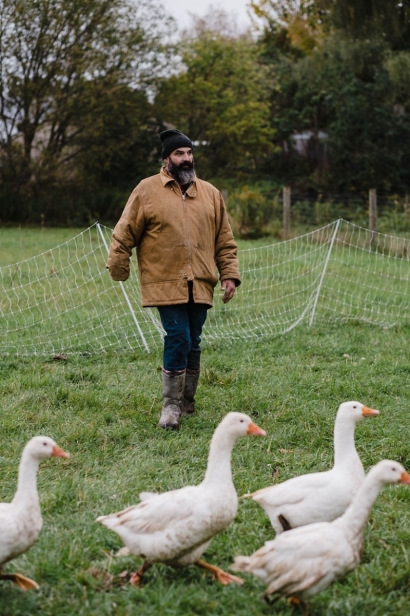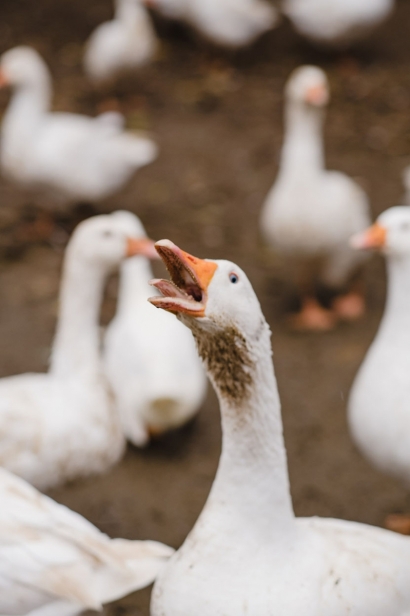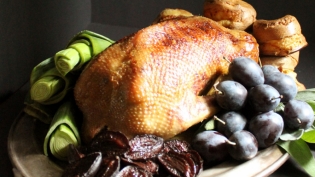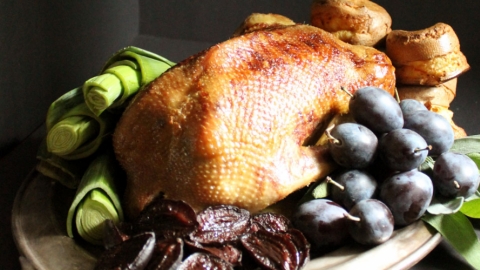A Storied Bird
As the calendar rolls through September, our eyes slowly begin to focus on the two major holidays not far in the offing — Thanksgiving and Christmas.
For some, this is a joyous and eventful time — times shared with family and friends. For others, this is a mad and frustrating time — times shared with family and friends. For others still, it’s boring and predictable — turkey and stuffing and naps after dinner.
But it doesn’t have to be like that — at least not both holidays.
“I think there’s an unwritten rule,” says Shane Van Casteren, operations manager of Nicholyn Farms, located on Horseshoe Valley Road in Phelpston, Ont., just north of Barrie. “You have to have turkey at Thanksgiving, but you can have almost anything else at Christmas. “In fact, you should have something else at Christmas.” Van Casteren has observed a trend over the years: Thanksgiving is normally a one-day event — the gang’s all assembled for the feast and then they head back to their respective corners. A turkey, in most cases, can feed the masses. At Christmas, the celebration is spread over a number of days — sometimes it's dinner and drinks with friends or a quiet dinner for two.
Turkey every day just won’t work.
Thankfully, there are options, many options — goose, Cornish hen, duck, pheasant, and even, Turducken. In fact, prior to what we would now call modern history, the goose was probably the most devoured celebration fowl on the planet.
Their history goes back thousands of years to Europe, where they were the perfect fowl for small farmers — they’re smart, economical to farm (grazers) and they’re tough as nails. Geese are also better able to resist disease and, pun entirely intended, foul weather.
Even though the meat-to-carcass ratio on a goose is lower than it is on a turkey, goose meat is much richer and is, pound-forpound, economical. A small goose of 3.5 kilograms (eight pounds) can feed four people.
“The Christmas goose was the meat of choice during Christmas past, but as the Victorian Era unfolded, the turkey took centre stage as they were easier to breed and cultivate in larger quantity and they provided more meat per bird,” explains Lisa Drake, a Durham Region poulterer who tends a breeding flock of flatheaded Roman geese. “Slowly, the goose dropped out of favour and was replaced by the turkey.”
“The Christmas goose was the meat of choice during Christmas past, but as the Victorian Era unfolded, the turkey took centre stage as they were easier to breed and cultivate in larger quantity and they provided more meat per bird. Slowly, the goose dropped out of favour and was replaced by the turkey.”
Drake, who has had geese for four years, but only started breeding this year, hopes her small efforts might stem that tide, at least for the Roman geese she tends. After all, this little goose is the variety that saved the Romans from invading Gauls in 390BC. (History has it that the invading Gauls were detected by the geese as all other manner of living creature — dogs and man — slept. Their loud honking awoke the Romans who successfully defended themselves.)
“I have a passion for keeping the heritage breeds alive, so we decided to tackle this one,” Drake says. “But because it’s so new to us, we haven’t actually been able to process and eat one of our birds. But that’s our plan.”
While Drake has to wait for that opportunity, others don’t have to.
Nicholyn Farms was started by Shane’s parents, Nick and Lynn, in 1982 and offers the region a wide assortment of meat, from traditional beef, chicken and lamb to more exotic tastes such as elk, venison and bison. As the holidays approach, Van Casteren prepares for the alt-fowl needs.
He said he’s seen the cycle repeat itself over the past number of years and it continues to grow.
“For a lot of our customers, goose represents a nobler time,” he says. “If there’s a once-a-year meat, it would have to be goose. It’s become a tradition for a lot of people and it’s an excellent lean alternative to turkey.”
Another lean alternative is pheasant, a dark-meat bird similar to goose. Notorious for its reputation as tough, dry meat, a properly cooked pheasant is anything but, and it's perfect for special occasions. A one-kilogram pheasant would be good for two and many recipes recommend laying bacon slices over the pheasant breast while cooking — truly something that will resonate with Canadian diners.
Definitely not lean, duck is another go-to fowl for the holidays. Prized not only for its succulent meat, duck fat is the stuff of dreams for chefs and foodies of all stripes. A properly roasted duck will yield crispy, mouth-watering skin and enough fat that you’ll be able to store it in the fridge for months and use it on everything from duck-fat hashbrowns to duck-fat glazed chicken. (Goose fat, Drake notes, is also highly prized and can be used in similar ways.)
A 2.5- to three-kilogram duck should provide a good meal for four, but remember, for best results, you have to poke and flip your duck every hour while roasting, so ensure you have four hours available.
Another holiday option is the Cornish hen, the perfect individual sized fowl.
“A Cornish hen is an excellent choice and it’s a very popular one,” Van Casteren said. “It’s small, it’s personalized, there are hundreds of recipes online and it’s often stuffed. I think it’s one of the most impressive servings you can offer.”
As versatile as any chicken, the Cornish hen is easy to prepare — rubbed with butter, garlic, rosemary and thyme and seasoned with a sprinkle of salt and pepper — and is ready in about an hour.
Regardless of your alternative fowl selection, Van Casteren and Drake recommend doing some research before you decide on the creature that will grace your holiday table.
“You want a quality product,” Drake says. “Talk with your local butcher or a local farm that offers [alternative fowl] for sale. Find out how they’re raised, what they’ve been fed and so on. And listen to your butcher or farmer on how to prepare them. These folks are experienced and they know their meat and how best to prepare and serve it. They really are quite invaluable.”











